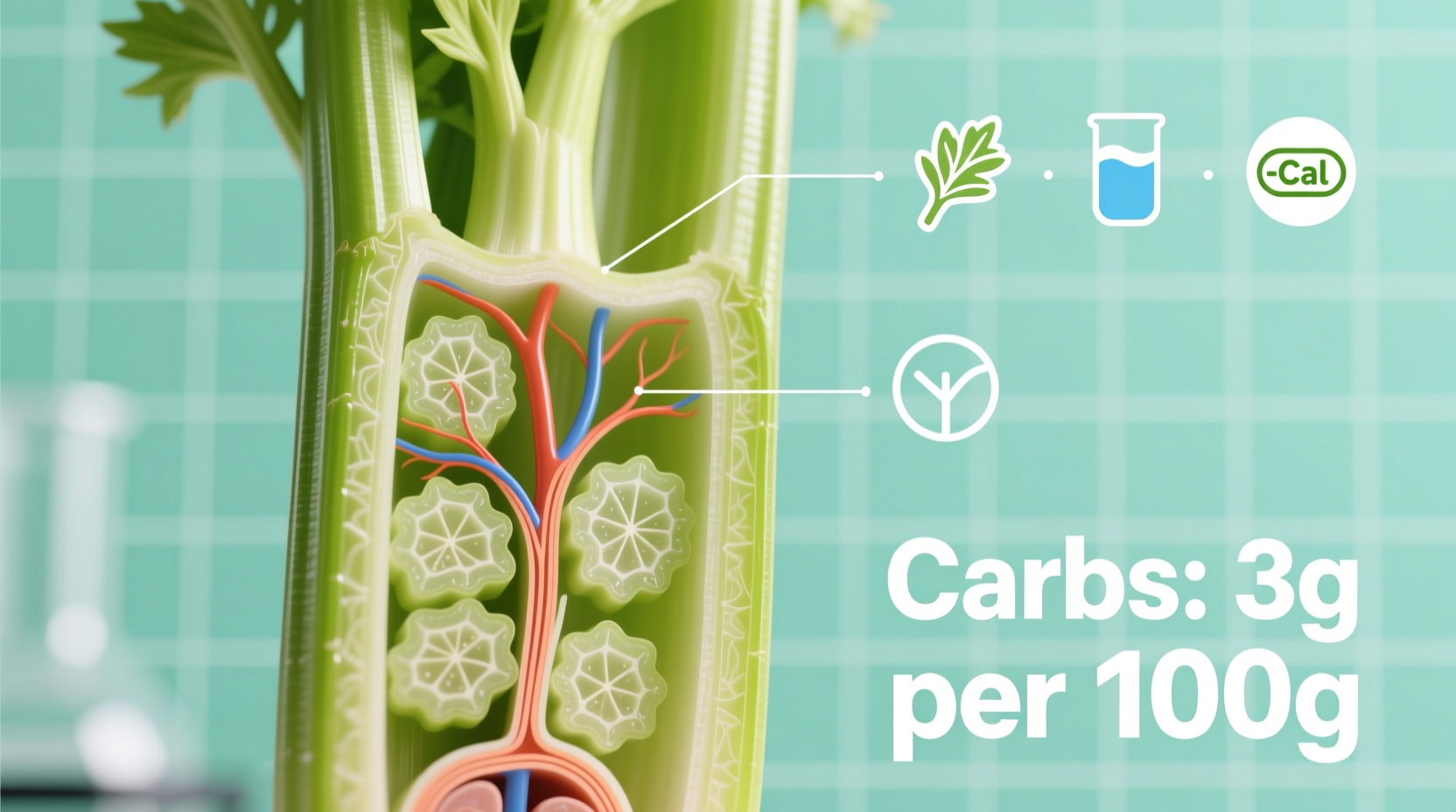When you're tracking your carbohydrate intake for health or dietary reasons, understanding the precise carb content in common vegetables becomes essential. Celery often appears on 'free food' lists in diet plans, but let's examine exactly what you're consuming with this popular crunchy vegetable.
Breaking Down Celery's Carbohydrate Profile
According to the USDA FoodData Central database, raw celery provides the following nutritional information per 100 grams:
| Nutrient | Amount per 100g |
|---|---|
| Total Carbohydrates | 2.97g |
| Dietary Fiber | 1.6g |
| Sugars | 1.34g |
| Net Carbs (Total Carbs - Fiber) | 1.37g |
This detailed nutritional breakdown comes directly from the USDA's official FoodData Central, the most authoritative source for food composition information in the United States. The data reflects raw celery, which maintains its lowest carb profile before any cooking or processing.
Practical Carb Measurements for Real-World Consumption
Understanding laboratory measurements is helpful, but what matters most is what ends up on your plate. Here's how celery carb content translates to common serving sizes:
- One medium stalk (40g): 1.2g total carbs, 0.6g net carbs
- One cup chopped (108g): 3.2g total carbs, 1.7g net carbs
- Entire head (400g): 11.9g total carbs, 6.5g net carbs
For those following strict ketogenic diets that typically limit net carbs to 20-50g daily, celery offers remarkable flexibility. You could consume nearly 3 entire heads of celery while staying within standard keto carb limits.

How Celery Compares to Other Common Vegetables
When evaluating vegetables for low-carb eating, context matters. Here's how celery stacks up against other popular vegetables per 100g serving:
| Vegetable | Total Carbs (g) | Net Carbs (g) | Fiber (g) |
|---|---|---|---|
| Celery | 2.97 | 1.37 | 1.6 |
| Cucumber | 3.63 | 2.13 | 1.5 |
| Zucchini | 3.11 | 2.51 | 0.6 |
| Spinach (raw) | 3.63 | 1.43 | 2.2 |
| Broccoli | 7.18 | 4.08 | 3.1 |
| Carrots | 9.58 | 7.48 | 2.1 |
This comparison clearly shows why celery ranks among the lowest-carb vegetables available. Only leafy greens like spinach and certain lettuces offer comparable net carb values. The data comes from consistent measurement standards used by the USDA Agricultural Research Service, ensuring reliable comparisons across vegetable types.
Maximizing Celery's Low-Carb Benefits in Your Diet
Understanding celery's carb content is just the beginning. To truly leverage this vegetable in your dietary plan:
Smart Preparation Techniques
Raw celery maintains its lowest carb profile. Cooking methods like boiling can concentrate sugars slightly as water content reduces, though the difference remains minimal. For strict keto followers, raw consumption provides the most predictable carb count.
Strategic Pairing with Higher-Fat Foods
Celery's natural crunch and mild flavor make it an ideal vehicle for healthy fats that support low-carb diets:
- Fill celery stalks with almond butter (adds healthy fats without significant carbs)
- Create 'ants on a log' with natural peanut butter and a few berries
- Use as a dipper for guacamole or full-fat yogurt-based dressings
Hydration and Satiety Benefits
With celery being approximately 95% water, it contributes to daily hydration needs while providing volume with minimal calories and carbs. This makes it particularly valuable for those managing weight alongside carb intake.
Common Misconceptions About Celery and Carbs
Despite its reputation as a 'negative calorie' food, celery does contain measurable carbohydrates. However, several myths persist:
- Myth: Celery has 'negative calories' that burn more energy to digest than it provides.
Reality: While celery is extremely low-calorie (16 calories per 100g), the thermic effect of food doesn't create a caloric deficit. The carb content remains positive, though minimal. - Myth: All parts of celery have identical carb content.
Reality: The leaves actually contain slightly more nutrients (and marginally more carbs) than the stalks, though the difference is negligible for carb counting purposes.
Special Considerations for Medical Conditions
For individuals managing specific health conditions, celery's carb profile offers particular advantages:
Diabetes Management
The American Diabetes Association classifies celery as a non-starchy vegetable, meaning it has minimal impact on blood sugar levels. With a glycemic load of less than 1 per medium stalk, celery won't cause significant blood glucose spikes.
Ketogenic Diet Compatibility
Registered dietitians specializing in ketogenic nutrition consistently include celery in recommended food lists due to its extremely low net carb content. The Academy of Nutrition and Dietetics notes that vegetables with less than 5g net carbs per serving generally fit within standard ketogenic parameters.
Practical Tips for Accurate Carb Tracking
To ensure precision when including celery in your carb-counting regimen:
- Use a kitchen scale for accurate portion measurement rather than estimating by volume
- Account for any added ingredients when preparing celery-based dishes
- Consider seasonal variations (winter-harvested celery may contain slightly more natural sugars)
- When dining out, assume prepared celery dishes may contain added sugars or higher-carb ingredients











 浙公网安备
33010002000092号
浙公网安备
33010002000092号 浙B2-20120091-4
浙B2-20120091-4